Whether or not you should prune a bare-root fruit tree depends on two things: One, what the tree looks like when you buy it. And two, what you want the tree to look like when it’s all grown up.
This being mid-January, heart of bare-root season in Southern California, I just planted a few trees in my yard and went through the process of deciding what to prune. So let me use those trees as our real-life examples.
The perfect pear
Meet my newly planted Fan-stil pear tree. Nice branch structure, wouldn’t you agree? Looks like a . . . tree. The trunk tapers from bottom to top; the branches are spaced vertically up the trunk; the branches spread into a pyramid shape, where the lower branches are bigger and wider. And what you can see from the photo at the very top is that the root system on this tree is also respectable. Thank you to the tree’s grower, L.E. Cooke (R.I.P.).
I won’t be pruning this tree at all until next year. One, it has all the above good qualities straight out of the nursery. And two, I want the tree to have a pyramid shape when it’s all grown up.
If I wanted this tree to have a globe shape (called “open center” among fruit growers), I would make one pruning cut to my pear upon planting. I would simply cut the trunk right above the fourth branch from the bottom. But in my experience growing apples and pears in Southern California, a pyramid (“central leader”) shape works better.
(How to choose a shape, or “training technique,” for your tree? See this article written by Chuck Ingels, University of California Farm Advisor and author of “The Home Orchard.”)
Cut back by one-third?
“But wait, I heard you should cut the branches back on bare-root fruit trees in order to restore the balance between the top and the roots or else they won’t grow well. They might not even fruit!” (Here are two reliable sources giving such advice: Dave Wilson Nursery and Orange Pippin.)
The idea is that the roots get cut or damaged some when the tree is dug up, and so now it has a proportionally larger trunk and branches compared to root system.
I heard that too, for years, and so I followed the advice. Sometimes nursery workers can get really pushy with this advice, making you feel guilty if you don’t let them cut some of the branches off your bare-root tree for you at the time of purchase. The pruning of bare-root trees does make theoretical sense, at least. But point me to the evidence, please.
A few years ago I performed my favorite type of experiment: Not doing something. What would happen if I didn’t do this “balance” pruning?
It was on a bare-root Fuji apple tree that I first tried not pruning “to restore balance” at planting time in January 2016. To my slight surprise, the tree grew fine. It even gave us a dozen apples this last summer, its second summer, which is on the early side for an apple tree. Here’s what it looks like today, nearly dormant here in January 2018:
Since that apple tree grew fine, last year I didn’t prune any of the half-dozen bare-root trees I planted. They were all different types of trees. And what do you know? They grew fine too. Here are a couple of the one-year olds today: (I’ll be giving them their first pruning soon.)
My conclusion is that you can follow the common advice to prune bare-root fruit trees back at planting time and they will grow fine, or you can leave them alone and they will grow fine. At least, that’s been my experience.
The cherry whip
Pruning is work. I work only when necessary. But sometimes pruning is necessary, for example, if your bare-root fruit tree looks like this. Meet my newly planted Royal Crimson cherry tree. “That’s a tree?” you ask. “Looks like a stake.” In the jargon, it’s called a “whip” when it has no side branches like this. For me, the buyer and future grower of the tree, it’s not optimal, but sometimes you can’t find a well-branched tree of the variety you want. So you manage — by making a pruning cut.
If I were looking to have a mature cherry tree that is very tall, say twenty feet or more, then I could plant this whip and walk away and never touch it with my pruners. It would grow into a tall, branching pyramid of a tree on its own.
However, I want a smaller, low-branching tree. This whip is about five feet tall, but I want side branches to form starting at three feet from the ground. Cutting it at a few inches over three feet from the ground will cause it to form those side branches where I want them.
I happen to have an example of a whip’s response to this kind of cut:
This is another bare-root cherry tree that I planted by the above Royal Crimson whip. What the close-up photo shows is that while this Lapins tree was growing in the nursery grounds, it had been cut. Below this cut, branches emanated, up to about five inches down the trunk. This is likely what my Royal Crimson whip will look like next winter, after I make the same kind of “heading” cut here at planting time. Then I’ll have the low branches I want for my grown-up tree.
One last thing to keep in mind is that a branch’s position on the trunk never changes. If a branch grows out from the trunk at three feet off the ground, it will always be at that height. The tree will grow taller, but the height of that branch on the trunk will not raise off the ground as the overall height of the tree does.
Hope all of this helps this winter as you consider whether to leave your new bare-root fruit trees alone or give them some directions through pruning cuts.
All of my Yard Posts are listed HERE

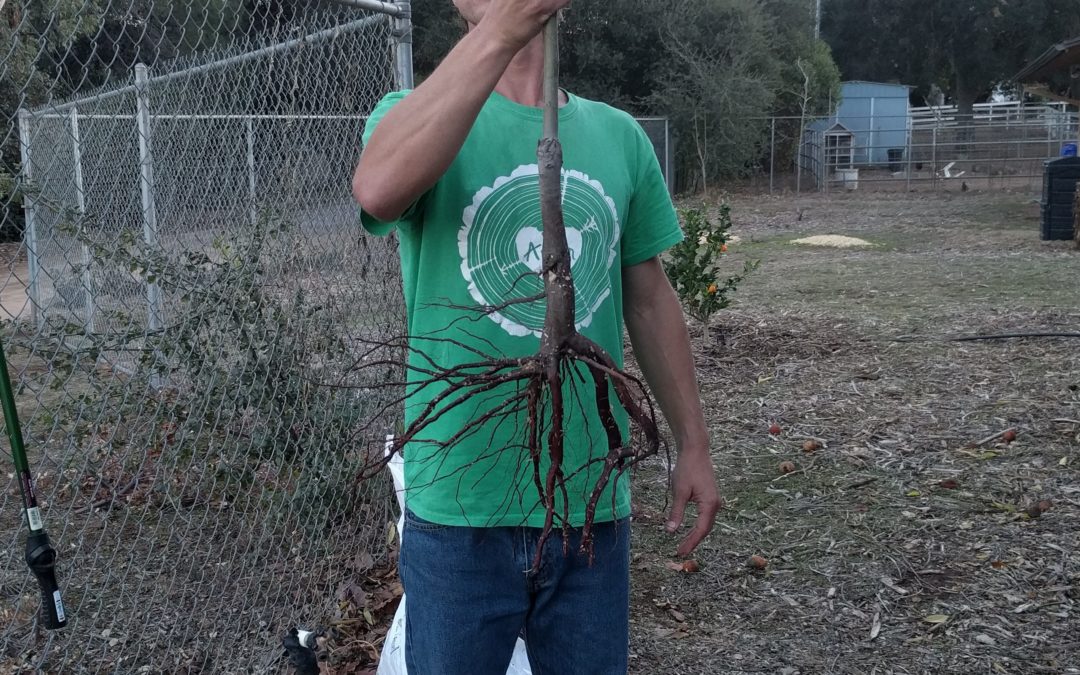
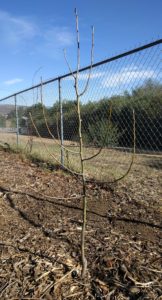
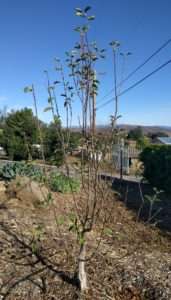
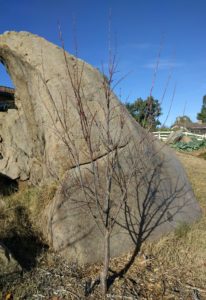
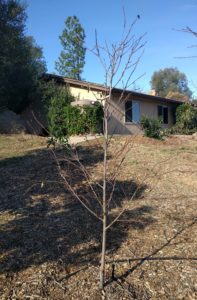

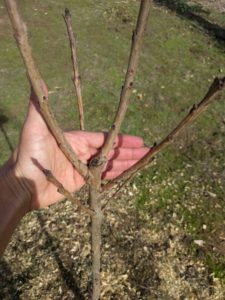


I just want to note that despite the Dave Wilson recommendation to cut even multi-bud trees back to 1/2-1/3 on each branch, this advice DOES NOT APPLY TO PEACHES. I learned the hard way. I cut my newly bought DW multi-bud peach back and only 3 of the 5 grafts survived. I am still fuming. Turns out peaches do not produce as many latent buds as, say, plum.
I’m so glad I found this piece before I cut back the two bare root peaches I just planted! Thanks for the helpful information, and I ordered my own copy of the Home Orchard as well!
Hi Jenna,
Great to hear this, and you will not be disappointed with The Home Orchard. I’ve been reading through sections for the umpteenth time just this last week.
Hello Dave, I just purchased The Home Orchard as well and am studying up on pruning until my bare root Apple and peach trees arrive this winter. Glad to know I don’t need to prune right away!
Question: if my bare root trees won’t have an available home in the ground until April or May, am I better off planting them in half wine barrels, or an equally large container, and transplanting them into the ground the following winter? Normally, I’m great about my fall/winter gardening schedule but my work schedule changed and it’s interfering with my garden plans ?
Hope all is well, and thank you for your advice a few months ago about where to plant raspberries in my LA yard.
Hi Kristin,
Shame that work gets in the way of the garden! I guess you’re going to have to plant them in a container when you get them. You can then transplant them in April or May, just treating them like any potted tree. But it might be hard to do that if you put them into a half wine barrel. (If you have strong help to get it done, then go for it.) Otherwise, it will probably be easier to do the transplanting if you put each into a container of about the 15-gallon size at most. You’ll likely have to prune some roots and the top of the tree a bit in order to do this.
Hello, I’m glad I found this site! Thank you for providing us with this information. I love gardening and I have been very successful with my berry bushes. I now I’m trying to grow fruit trees. I received a cherry barefoot as a gift about six weeks ago. The top part of the tree appears dead. I did the scratch test and it doesn’t have a green layer. However, half way down the bark does have a green layer. Should I prune and remove the top layer of the tree. I really want to save this tree. Thanks for your help!
Hi Miriam,
I wouldn’t prune anything if I were you. I would just let the tree show you where it is still alive as it grows out leaves.
But where do you live? How is it that you are planting a bareroot cherry tree in July?
Thank you for your reply. I live in NY and I received the bare root Cherry tree as a gift in May. I planted it once I received it, however it’s still not budding.
Thanks so much for posting this. I had questions about pruning when planting a bare root cherry tree. I couldn’t bear to do it as it looked perfect the way it is.
I thought that the one of the reasons for cutting back the tree around planting was to develop low scaffold branches.
You’re right. That’s the reason I cut back the cherry whip shown above.
I ordered a Lapins Cherry tree online and received a 1″ (4 ft tall) stick with roots. I planted it in the ground 6 weeks ago with a little bio starter, and put it on a bubbler for irrigation, but it hasn’t leafed out at all. It isn’t dead–scratching the tank shows green underneath.
At 1″ diameter, it’s too thick to cut off the top with a hand pruner like you did. What do you recommend?
I have a bare root apple tree that was somehow broken in the middle 2 years ago and the top was removed. What remains is about 3 feet tall now. We had one small branch grow out from the side last year, about 3 inches from the dead split top, but that died. I see we have 2 new small branches growing from the very bottom of the tree – at most about 5 inches from the ground – and the branches are actually growing off of smaller side shoots, not the main branch itself. Do I cut these off in favor of trying to promote growth coming from somewhere higher, or let them stay? They are the only part of the tree that appears alive. I’m not sure if the tree is dying from top down due to the damage sustained, and if I need to cut the center whip even smaller to try to save it. Any advice welcome.
Hi Cal,
It sounds like the tree is struggling so I wouldn’t cut anything at this time. Often, when I’ve pruned a struggling tree, the tree has just quit and died.
Cutting the tree is done so that instead of the young plant trying to produce roots and shoots at the same time, the top growth comes in later sending more rooting hormone to the roots. This establishes a much better root system , stronger healthier tree and increases over all longevity. It also produces stronger branches that will bear more fruit without breaking. Yes it will grow and produce, nature is miraculous. The role of the human is how to best assist that process.
Hi Dee,
Yes, that is the explanation that is repeated endlessly, but is there any evidence for it? I’ve never seen a speck of evidence to support it. I’d love to see some if you know of any.
As I mentioned in the post, in my own experience I’ve pruned bare-root trees and not pruned them — dozens of trees in multiple locations — and I haven’t noticed any better growth from those that I’ve pruned, not in the short run or long run.
Hi Greg. Thanks again for allowing us to use your experiences and knowledge. This year I was able to put in a bunch of bare root fruit trees. My Blenheim apricot sprouted many new branches in the first 6-8 inches above the graft and nothing at all above that. Should I just cut off everything above the new growth or wait it out to see what happens. Also my flavor kings (I planted 2) have made many root suckers but is showing no signs of growth above the graft. I have been cutting off the suckers as I see them but I wonder if this is normal or is it a sign that my plants aren’t doing well. Are these things you have seen before? Thanks again
Hi Walter,
Yes, I’ve seen these things before. One cherry I planted only sprouted branches a few inches above the graft and eventually the trunk higher up just died back. I actually never cut the dead part out and the tree is doing fine. But I’m sure you could cut that top, dead part out with your apricot if you wanted, if it does end up dying back.
My own Flavor King always has many rootstock suckers. I just removed a bunch yesterday. It is on Myrobalan 29c rootstock. However, the adjacent Dapple Dandy pluot tree is also on Myrobalan 29c (it was tagged that way, at least) but rarely has any rootstock suckers.
My flavor kings trees were bought at Home Depot so you never really know but, they were marked as dwarf so I assume they are on citation. Either way they’re still showing no signs of life above the graft. At what point do you give up on it and try again next year?
Also, I wonder if the increased rootstock suckers on our flavor kings is because the plant has a relatively vigorous rootstock under a less vigorous tree. What do you think?
Hi Walter,
Have you scratched the bark to see if it’s green underneath?
That’s a good idea about the reason for increased suckering on Flavor King. I hadn’t thought of that, but it’s possible.
Just scratched the bark on both of them. They are dry and dead underneath. It’s disappointing because all the bare root tree sellers seemed to be sold out of flavor kings when I was looking. Felt lucky to find a couple at Home Depot. Also the flavor king seems to have the best flavor of the pluots based on opinions I have gathered from online forums. Guess I can add another year to my wait to try one. Thanks for the reply and sharing your knowledge.
Sorry to hear it, Walter. Flavor King is a good one, for sure.
I planted two nectarines and a nectaplum and cut them to 3 ft as DW recommends. I am also getting branching low on the trunk. The branches are pretty vigorous. I tried notching by using a fine file over the highest buds to try to get higher branching. Do you have any recommendations to get higher branching? I read that training a branch to be a new trunk is an option. I don’t think I want to do that though. Anything helps.
Thanks.
Hi Dan,
I’m sorry but I can’t think of any way to get higher buds to break other than what you’ve already tried.
Got a small (4’) dwarf pair in the ground 8 weeks and tiny buds have just begun enlarging. Top of tree (trunk leader) is dead and dry for top 6” down to top branch (actually to below it on one side of trunk)
Should I amputate?
I understand the concept of pruning to an outward-facing bud or branch on a fruit tree . But what if I have 10-foot long branches growing straight up on my pluot tree that have only leaves and no buds or lateral branches? Can I just arbitrarily pick a length that I like for those branches and just haphazardly chop them off? Or would I get terrible flushes of non-fruit-bearing water sprouts and possibly even shock the tree or cause disease?
I have a newly planted bare root peach tree (6weeks ago) , in massachusetts.
The top or main tree is showing no leafing out . The bottom above the scion has vigorous new growth (12″ or more) what should I do ?
I have scratched bark to see if alive , seems to be .Do I leave be and wait or when might I cut and establish a new central lead from the bottom growth above scion .
Ps. If I don’t act the lower growth will soon get out of control .
Thank you paul I appreciate any help
My experience with Fujis is that they are on a dwarfing root stock. They seem to do just fine with pruning or without. My big problem has been coddling moths. Resorted to poison on the blossoms and still got some worms but a nice harvest of tasty apples. Christmas is the perfect taste if you ask me. Sweet, crisp, still tangy. But thick skin. Peel it and feed to your worms!